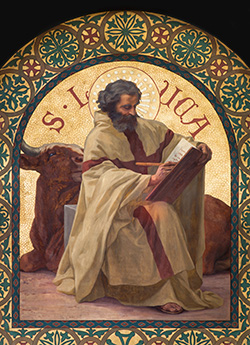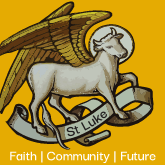 Feast Day: 18th October
Feast Day: 18th October
Luke the Evangelist is one of the Four Evangelists and authors of Jesus Christ Gospels. Luke was born in Antioch in Syria.
In the New Testament, Luke is mentioned as a doctor, although he is thought to have been both a physician and a disciple of Paul.
Luke died at age 84 in Boeotia, his tomb was located in Thebes (Greece), from whence his relics were transferred first to Constantinople, later to Padua.
In traditional paintings, St. Luke is often accompanied by an ox or bull, usually having wings. This is his Evangelic symbol.
The relics of St. Luke are so divided: the body, in the Abbey of Santa Giustina in Padua; the head, in the St. Vitus Cathedral in Prague; a rib, at his tomb in Thebes.
pdf
The Tomb of St Luke the Evangelist
(975 KB)
Prayer to Saint Luke the Evangelist
Lord God, who chose Saint Luke to reveal by his preaching
and writings the mystery of your love for the poor,
grant that those who already glory in your name
may persevere as one heart and one soul and that all nations
may merit to see your salvation.
Through our Lord Jesus Christ, your Son, who lives and
reigns with you in the unity of the Holy Spirit, God,
for ever and ever. Amen!
Saint Luke the Evangelist: Pray for us.
Patron Saint of artists, physicians, surgeons, students and butchers.
In the early Church, the “four living creatures” that encircle God’s throne in the Book of Revelation (4:7-8) became symbols for the evangelists.
These symbols originated from the four-sided creatures described by the prophet Ezekiel 600 years before the birth of Christ. “Within it (a storm wind) were figures resembling four living creatures that looked like this: their form was human, but each had four faces and four wings ... Each of the four had the face of a man, but on the right side was the face of a lion, and on the left side the face of an ox and finally each had the face of an eagle.” (Ezekiel 1:5, 6 & 10)
St. Jerome, in the latter part of the fourth century, attributed these symbols to the four canonical evangelists. The Gospel of Matthew begins with the Incarnation, so his symbol is a man (or an angel). Mark begins his Gospel with John the Baptist whose “voice crying out in the wilderness” was as solitary and powerful as a lion’s roar. Luke stressed the theme of sacrifice, so the figure of the ox was associated with him. And John’s Gospel, according to St. Jerome, achieved spiritual heights and therefore soared like an eagle.
Some additional links about St. Luke and his church,





 17 Stevens Road, Vermont VIC 3133 | 03 9412 8499
17 Stevens Road, Vermont VIC 3133 | 03 9412 8499